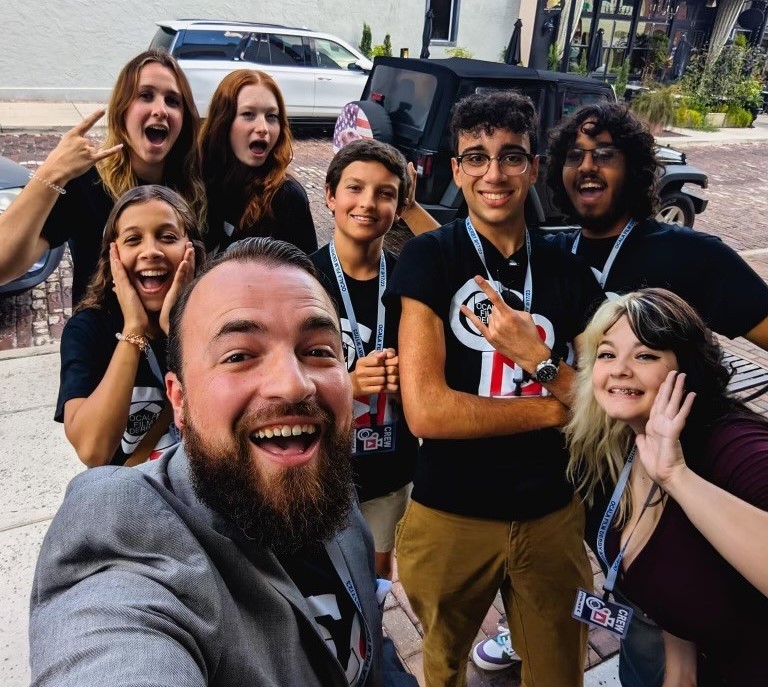Ocala Film Derby Premiere
Over the span of a few hours last week, student teams produced films that were planned, written, shot and edited in downtown Ocala.

These are members of the award-winning Reelists team in the Ocala Film Derby, with mentor Mike Palma in the foreground. [Photo courtesy Laurie Zink]
The inaugural Ocala Film Derby, which took place from Sept. 13-17, was a smash hit, according to many of the people who were involved. The starring cast and crew included Marion County Public Schools students, mentors, teachers, sponsors and organizers. So, turn up the neon lights and let’s do a storyboard treatment for how this evolved.
The Backstory
There was a time when the Silver Springs International Film Festival (SSIFF) drew up-and-coming and veteran filmmakers to Ocala.
The festival was created in 2014 to elevate awareness of Ocala/Marion County, Silver Springs State Park, and the area’s contributions to the cinematic arts (Movies filmed here have featured stars such as W. C. Fields, Louise Brooks, Elvis Presley and Johnny Weissmuller.). The Ocala Film Foundation was simultaneously created to put on the festival and several other ventures, including Jump/Cut, Cinema Sundays and the Walk of Fame, which features local “star” plaques embedded in the sidewalk in front of the historic Marion Theatre.
Two key players in foundation activities were longtime community leader Laurie Zink, currently the development and community outreach director for the Institute for Human and Machine Cognition (IHMC), based in downtown Ocala, and Greg Thompson, the current executive and artistic director of Ocala Civic Theatre. In 2018, Zink explained that because the SSIFF was so successful, they couldn’t keep doing it in its format at that time.
“It grew from being a $65,000 budget the first year to more than $400,000 by the fourth year,” she said in published news reports. “We had nine filmmakers the first year, and by the fourth year, 78 filmmakers came from all over the world. The only reason we’re not doing it anymore is because this community cannot support a half-million-dollar budget every year.”
In the meantime, Zink continued to serve in numerous volunteer roles and presently is chair of the Marion County Public Schools (MCPS) Career and Technical Education Audio/Visual Arts Business Advisory Council.
She said she kept reflecting on the SSIFF, in particular the Jump/Cut component, which was for adult filmmakers, and wondered if it might work with area school students.
“I was trying to think of something that could be lasting, if we could build a program that could be sustaining,” she offered. “I talked to Greg and said, ‘Will this work?’ We outlined it, and we did it. We put together a committee of high school teachers, including David Guest from Forest, Marcia Daubenmire at Vanguard, Andrew Opitz with West Port and Travis Bennett at Lake Weir.”
The Time Frame
Zink said the committee ironed out rules for the derby and invited schools to participate. The schedule included a reception at IHMC on Sept. 13, where students from Forest (FHS), Lake Weir (LWHS), Vanguard (VHS) and West Port (WPHS) high schools and Belleview Middle School (BMS) met with community stakeholders and industry professionals.
“The students were blended into teams, where they didn’t necessarily know anyone else,” Zink said. “Every team had a mentor from the community and a teacher. They all met each other on Wednesday night and started planning.”
On Sept. 14, the mentors visited schools and talked about video, film technology, career development and a little bit of strategy on the film derby, Zink said.
The morning of Sept. 15, the teams met again at the IHMC offices, which were outfitted with editing stations. Each team was given a character—Morgan Morganstern; a prop—a small paddle such as one that would be used for table tennis; a downtown location—the Ocala Film Foundation Walk of Fame in front of the Marion Theatre; and a line of dialog—”This is the hill I want to die on.” They also were given a list of downtown businesses that had agreed to let them film at their locations.
Beginning at 9 a.m., they had nine hours to plan, shoot and edit their films and turn them over to the committee by 6 p.m.
On Sept. 17, a film screening and awards ceremony took place at the Marion Theatre. On hand for that event was Ocala’s own multi-award-winning videographer and photographer Mark Emery, whose accomplishments are acknowledged by his star on the Walk of Fame. Zink said his remarks were very “inspirational” and that the students crowded around him for photo ops.
She also said the judges talked with the students about the importance of team collaboration, not just being the best at any one aspect, like editing or camera work or acting.
The Teams and Their Entries
- Team T.B.D, “Late” (youtu.be/6-x0A7hlirw)
- The Phoenix Team, “Execute Operation Morganstern” (youtu.be/NBuvrL44SbA)
- Spontaneous Studios, “The Interview” (youtu.be/kDAvH3D710M)
- The Rubber Duckies, “The Ping Pong Legend.” (youtu.be/Cs74c1RXvog)
- The Reelists, “Lovestruck” (youtu.be/uRKOim6wgj8)
And the Winners Are!
- Judges Choice: “Lovestruck”
- Audience Choice: “Lovestruck”
- Best Use of Prop: “Lovestruck”
- Best Use of Downtown Landmark: “Ping Pong Legend”
- Best Use of Character: “Ping Pong Legend”
- Best use of Line of Dialogue: “Operation Morganstern”
Starring Roles
The Reelists team members were Parker Tew, camera person, FHS; Suriana Im, director, FHS; Samantha Anderson, actress, FHS; Luis Semidei-Lossada, editor, FHS; Ella Gutierrez, writer, BMS; Sierra Stephens, writer, LWHS; and Edwin Colon, actor, LWHS. Their teacher was Marcia Daubenmire, from VHS, and their mentor was Mike Palma, with Palma Productions.
Daubenmire has taught in MCPS for more than 16 years, her last three at VHS.
“The DVT (Digital Video Technology) program is focused on growing students to learn all three parts of production. DVT 1 students have the opportunity to certify in Premiere Pro and After Effects and learn the basics of good filmmaking. DVT 2 students challenge themselves in the world of broadcast journalism. DVT 3 students continue to perfect their craft and work in world storytelling through film. DVT 4 stretches our students to think about and prepare for the next step,” she explained.
“The student teams were created on Wednesday evening and Friday morning they were given their prop, line of dialog, character and location that was required to be in the 3- to 7-minute short film. From that point, the team worked like a cohesive unit. They sat in their team area with Mike and brainstormed ideas. Suriana selected the story and Sierra wrote what they felt they could bring to life and Ella started to put the storyboard together,” Daubenmire added.
Samantha Anderson said everyone “was together helping with the script, but our middle school writer and director did the most. Although in general, the plot and idea of our film was everyone’s ideas put together.”
As for how she developed her character of Morganstern, “I would kind of imagine myself in the scene. Like how would I act in this situation? As the filming got farther along, I got more comfortable with my acting. I had to act as if the cameras weren’t there, as if this is real life and how it should be portrayed,” she noted.
She said she enjoyed the team format and that, “Working with a team results in more ideas, which can result in better stories. In a team there is more organization, mostly when there are set jobs. Everyone individually put in the effort, and it resulted in a great, well-produced video.”
From the editor’s perspective, Luis Semidei-Lossada offered that it was, “definitely stressful, especially right at the end, but nothing I’m not used to. We do 8-hour film competitions at something called the STN (Student Television Network) convention, which is a way for students who are interested in video production to work hands-on and learn with professionals in the industry.”
He said that through the day he followed the film crew and occasionally ran back to edit parts of the footage, which helped “to visualize the order of the scenes and how exactly to depict them.”
“I definitely want to be a part of the video production industry, whether it’s working on films or things like journalism. What I find particularly appealing is that there’s no one right path in the industry and there’s a lot of room to grow,” Luis added.
Director Suriana Im said it was “definitely intimidating having to complete the video in nine hours, but I feel like coming from FHS I had an advantage. I went to the STN (Student Television Network) convention last year in Long Beach, California, where we had eight hours to complete a news show, so that definitely prepared me.”
She said they hit one stumbling block about an hour out when they learned that the platform they used for sound effects apparently wasn’t allowed, “so we had to go out and foley everything. In the end we ran out of time for sound effects, so that was a little bit of a letdown.”
But the team soldiered on.
“My group learned so much from our mentor Mike Palma. I’ve never directed a film with an actual crew before, so it was a learning experience for me. I loved it. I really got to see my vision come together because of everyone’s hard work,” Suriana said.
“My interactions with the students consisted in guiding them and suggesting ideas in thinking critically and things that would consist in higher production quality, teaching them new ways to think and approach their skills,” Palma said. “They learned leadership, teamwork, strategy, on the fly thinking when things needed to change to make up for time and for the betterment of the finished product. They also learned practical skills in shot composition, lighting, storytelling, acting and behind the scenes roles like directing, director of photography and editing. We had much synergy working together. I learned or revisited from them what it was to have that curiosity, that wonder while working on something creative. That joy and willingness to work together for the greater good of the project and to celebrate together. They were very humble and appreciative, and that was a reminder to always stay that way and enjoy the process.”

Participants in the inaugural Ocala Film Derby. [Photo by Tommy Cuevas]
“It was a huge collaboration. Now we have a template to work with,” Zink offered. “And I want to thank all the sponsors and next year we’d like to see the awards turn into scholarships for the kids.”
Palma shared that he is a product of MCPS, which helped prepare him for his career, and said he learned something through the derby.
“I went through the local school system as well, graduating from Belleview High School and participated in their television production program. Because of that program, I discovered my passion and have always kept that dream alive to make that my profession. I have been doing video ever since, and plan to keep growing and provide quality products for my clients,” he stated. “As an artist in many different ways, I understand what it takes creatively to help businesses grow and now I also understand what it takes to help teach students what they need to know in order to progress after my experience in this phenomenal derby.”




